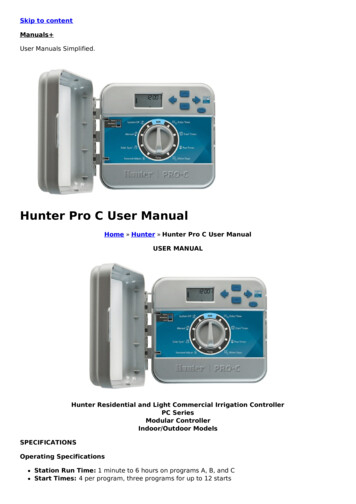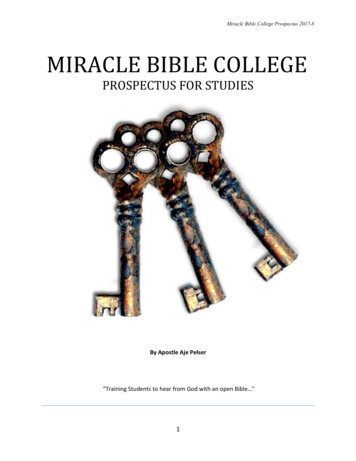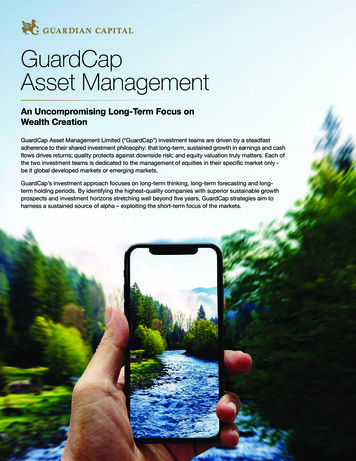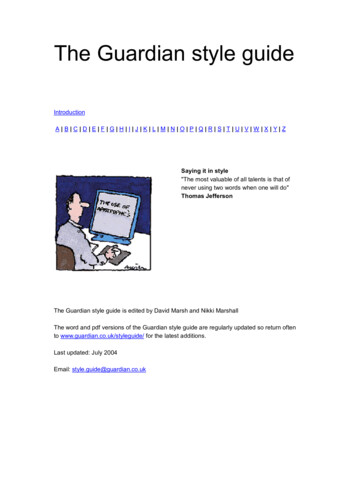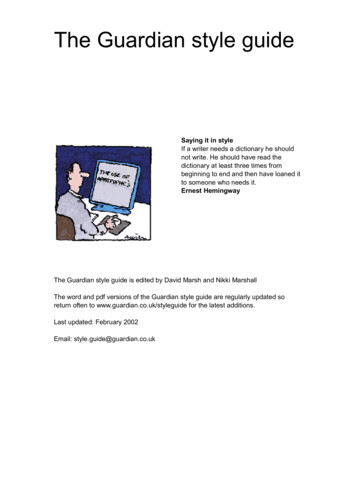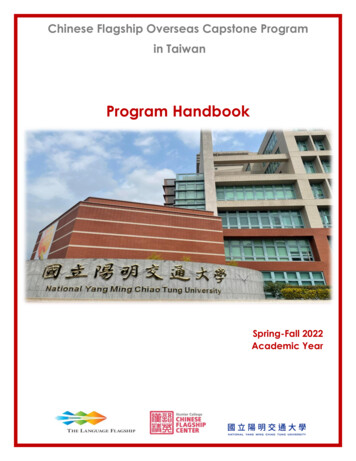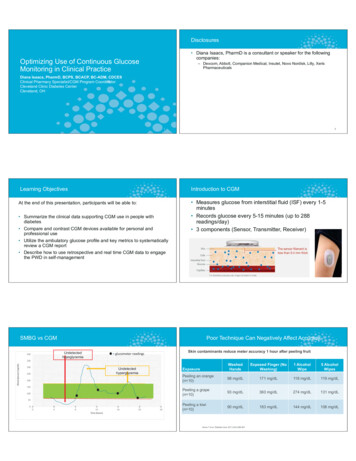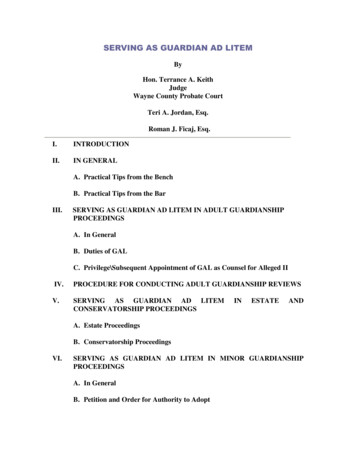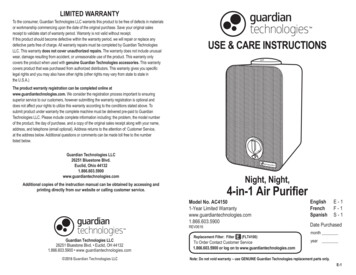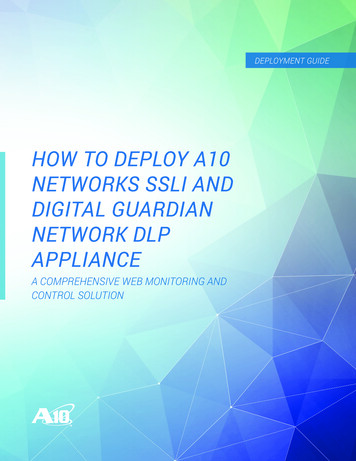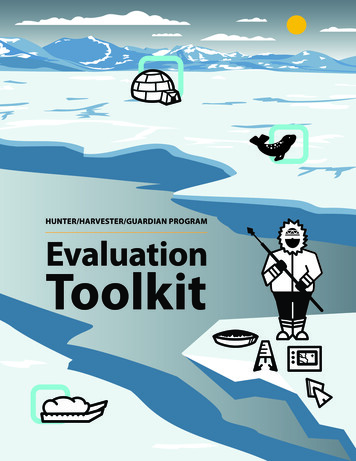
Transcription
HUNTER/HARVESTER/GUARDIAN PROGRAMEvaluationToolkit
June 2021Prepared for MakeWay by the Social Researchand Demonstration Corporation (SRDC) inpartnership with Shari Fox, Ph.D.MakeWay is a national charity and public foundationwith a goal to enable nature andcommunities to thrivetogether. We do this by building partnerships, providingsolutions, grants,and services for the charitable sectoracross the country.ACKNOWLEDGMENTS:SRDC thanks and acknowledges the contribution ofkey informants to this research, including representativesfrom the Qiqiqtani Inuit Association, the Government ofNunavut, and Nunavut Tunngavik Incorporated.The toolkit was commissioned by MakeWay andguided by Steve Ellis and Lori Tagoona of MakeWay.DISCLAIMER:The views and opinions expressed in this paperare those of the authors alone, and not of MakeWay.RECOMMENDED CITATION:Social Research and Demonstration Corporation. 2021.Hunter/Harvester/Guardian Program Evaluation Toolkit.110 pp.Manual art direction/production by Beverly Hancock(bevdidthat.design)Visual storytelling through illustration by Nooks Lindell/Aqquimavvik (see back cover for further information)
In this ToolkitBackground /1i.Evaluating Hunter/Harvester/Guardian Programs /2The Hunter Pilot Project /2Evaluation and the Hunter Role – How to Show What We Know /3The Process /4Building a Common Language /6Identifying Outcomes /7Bridging from North to South /8Orientation /101.0Information /11Activities /11How can Evaluation Centre Indigenous Values? /11Why do Evaluation? /13Where are you at with your Program? /14Assessing Pre-conditions for Program Implementation? /16Where are you at with your evaluation? /17Evaluation needs Assessment /18Planning /192.0Picking Evaluation Questions /20Logic Model Builder /26How to Measure Activities and Outcomes /44Literature Reviews /88Theory of Change /100Value for Money Evaluation /101
In this Toolkit3.0Doing /56Data Collection /59Data Management /61Data Anaysis /63Sharing /664.0Who /67Why /68How /68Report Template /69ii.Deeper Dive /73Tools:Activity Report /79Existing Surveys /80Information Management System /83Hunter Tracking Sheet /84Meat Medallions /85Literature Reviews /88Theory of Change /100Value for Money /101iii.Glossary of Terms /105
i. Background1
i.IntroductionEvaluatingHunter/Harvester/Guardian programsHunter, harvester, and guardian roles are inherently valuable to northern Indigenous communities andprovide a suite of social, economic, and environmental benefits.The Social Research and Demonstration Corporation (SRDC), anon-profit research organization, in partnership with Shari Fox andMakeWay, engaged in an extensive literature review, environmentalscan, and series of convening events with Indigenous organizations,rightsholders, and practice experts, to co-create this evaluationframework for hunter/harvester/guardian programs.You can learnmore about SRDCat www.srdc.org,and Makeway atmakeway.org.Our hope is that this evaluation framework and toolkit is a resourcethat organizations and communities can use to plan, design, and doevaluation of hunter/harvester/guardian programs.Thehunter pilotprojectThe evaluation approach for Hunter/Harvester/Guardian programs builds on initial work by Dr. Shari Foxand Esa Qillaq on a pilot project in Clyde River, Nunavut. Esa Qillaq, an expert hunter, received a full-timesalary comparable to other professions in the community (e.g. nurses, teachers) in order to pursue hisactivities as a full-time hunter. The pilot project was over one year long and administered throughIlisaqsivik Society, an Inuit-led non-profit organization located in Clyde River. Esa’s job description took aholistic approach to hunting, understanding that many things fall under the category of hunting activities,and that hunting includes much more than harvesting animals for food. The pilot project analyzed huntingdiaries kept by Esa to look at the types of activities undertaken, distance travelled and travel routes, harvestyields, and sharing of country food. Additional interviews and discussions explored topics such as the needfor consistency, the important roles country food can play in cultural preservation and maintainingtraditions, skills, and language, the value of ongoing environmental observation, knowledge andmonitoring change, and the role of hunters as keepers of cultural knowledge, values and traditions.2
IntroductionEvaluationand thehunter/harvester/guardian role –How to showwhat we knowThe evaluation approach developed through the pilot centred the hunter.It showed the impacts a hunter has on different domains of society(e.g., food, social, health, knowledge, culture) through their actions, as wellas how those different domains impact them. The approach identifiedelements of a program logic model, including:1what is required to support hunters/harvesters/guardians;2the types of activities hunters/harvesters/guardians”might engage in and what that would bring intothe community; and3what that would mean for the individual hunter/guardian, their family, community, society and culture.3
kFinal EvaluationFrameworkand ToolsEngagementEngagement ReviewDraftEvaluationFrameworkand Approachto Return onInvestmentSRDC worked withShari Fox and MakeWaythroughout the phasesof this project, to build onShari and Esa’s work, and toreview, scan, convene, andsynthesize what we heardfrom multiple perspectives.The process of creatingthis evaluation frameworkcentered input fromcommunities, organizations,and northern Indigenouspeople who will beusing it. Our overallprocess is outlined here.An emerging body of literature outlines Indigenous approaches to research and evaluation, as well asdecolonizing practices. These include placing Indigenous communities and Peoples at the centre of theevaluation process from the conceptualization of the evaluation purpose and audience, lines of inquiry,and processes by which data are collected, analyzed, and reported. Given the legacies of colonization,including unethical and harmful practices in and approaches to research and evaluation, decolonizingresearch and evaluation means acknowledging these legacies, and grounding evaluation in Indigenousvalues and principles.Because this framework was co-developed primarily in the context of programs in Inuit Nunangat,the development of the framework is guided by all Inuit Societal Values (ISVs), and in terms of process,Piliriqatigiinniq/Ikajuqtigiinniq, Inuuqatigiitsiarniq, and Aajiiqatigiinniq. We hope this framework canbe helpful to other Indigenous Hunter/Harvester/Guardian programs and communities – please seethe How can evaluation centre Indigenous values on page 11 related to values and context formore information about how to ground evaluation in community approaches.4
IntroductionWho is thistoolkit for?This is a set of resources for people who, and organizationsand communities that are:1currently running programs involving a hunter/harvester/guardian role;2planning to run a program/programs involving a hunter/harvester/guardian role; and/or3interested in learning more about planning and doing an evaluationof a hunter/harvester/guardian program, or other similar programs(e.g., land-based programs).It is also for hunters, harvesters, guardians, and community members.We hope you can use this resource to build an evaluation plan, and explore tools that you can use andadapt/tailor to your needs. If you are already doing evaluation, feel free to take what is helpful, and leavethe rest! We recommend you move through the toolkit as follows on the next page.5
IntroductionBuildinga commonlanguageIn this toolkit, we use specific terms and language. For more information on these terms, please check outthe Glossary of Terms on page 105 for definitions and descriptions.We use specific language with the goals of:1. Building a common language and set of key terms to refer to program activities, roles,and outcomes, from an Indigenous and Northern-centric perspective; and2. Bridging between Indigenous ways of knowing, Northern perspectives and evaluationterminology; and Southern or non-Northern audiences.H unterH arvesterG uardianor languageThe term ‘hunter’ is expanded to include harvester and guardian. Although activities may differ betweencommunities and programs the hunter, harvester and guardian roles are unified in terms of how theiractivities aim to achieve short, medium, and long-term outcomes for individuals, families, and communitiesacross the North. Throughout this document, we will refer to the role of the hunter/harvester/guardian asthe HHG. Broadly, all three terms refer to a role, if supported as an essential service, that secures consistentrelationship to the land, access to country food, acquisition, practice and sharing of environmentalknowledge, and other associated outcomes.6
IntroductionIdentifyingoutcomesWe recognize that there are many benefits of HHG programs – in this toolkit, we have started by focusingon four outcome areas based on what we heard from Indigenous communities, organizations, andrightsholders that are operating or supporting these programs in the North. Through those conversations,we heard that almost all HHG programs prioritized these four outcome areas (About the Illustrator and hisnotes can be found on page 111):Food Sovereignty ConservationIndigenous-centered EconomyHealth and Well-beingPriorityOutcomesOUTCOMEFood SovereigntyDEFINITIONEvery household having daily access to country/wild foods of choiceWe refer to food sovereignty as opposed to food security, as food sovereignty relates not only to having secureaccess to food, but importantly to having the power to choose what foods are accessible (e.g., country/wild foods).Health and Well-beingHolistic well-being inclusive of physical health, mental health, socialand emotional health, and a sense of connectedness to culture, theland and each otherIndigenous-centeredEconomic DevelopmentEconomic development grounded in access to harvested materialsand diversion of resources to local economic production/activitiesConservationHealth and well-being of plants and animals (including humans),as well as habitats/ecosystems, and real-life knowledge ofenvironmental changes7
IntroductionBridgingfromNorth toSouthA key reason for evaluating of HHG programs is to build the ‘evidence-base’ about best practices indelivering such programs, and to demonstrate their effectiveness to external stakeholders. For example,some funders of programs in Indigenous contexts require quantitative, numbers-based metrics that aredeveloped without engaging communities or participants in programs being evaluated. Although thereare tools that can help programs build towards an economic evaluation of their activities and outcomes,the overarching goal of having a common approach to evaluating HHG programs is to capture changesand stories that are important within communities from communities’ perspectives.Below are some resources that help both unify and project the voices of organizations and communitiesdelivering HHG programs, including guardian programs.On-the-land Program Evaluation 372/final otl evaluation meeting nov1-2 2018 report.pdfIndigenous Approaches to Program out Inuit Societal luesIncorporating IQ in Research and Evaluation:www.nwtontheland.ca/evaluation.html8
What is in this Toolkit?This is a set of resources that can help plan and do evaluationof programs involving a hunter/harvester/guardian (HHG) role.There are four steps to walk through:OrientationBuilding yourFoundationPlanningIdentify values that areimportant for your evaluationFigure out where your programis at nowFigure out what you want toget out of an evaluationMaking anEvaluationPlanAt the end of the ORIENTATION section,you will know what kind of evaluationyou want to do, can do, and should doPick evaluation questionsBuild a logic model for your programAt the end of the PLANNING section,you will have an evaluation plan thatfits your HHG programDoingPicking Toolsto do yourEvaluationFigure out the Who, What, When,Where and How of evaluationIdentify what data you’re goingto collect and how to store itIdentify how to analyze andpresent your dataAt the end of the DOING section, youwill have tools to put your evaluationplan into action for your programSharingCommunicatingwith Funders,CommunityMembers, andother AudiencesExample reporting templatesTips for communicating withfunders about evaluationAt the end of the SHARING section,you will have resources to help youshare your evaluation findings withyour target audiences.9
1.0 Orientation10
Orientation1.0How can evaluation centreIndigenous values?1Evaluation can serve as a tool to helpmove towards self-determinationand advocate for more investmentinto programs and services thatare responsive to the strengths,challenges, and resources withinIndigenous communities23Many Indigenous-centredapproaches highlight processesthat ensure community voiceand Indigenous organizationsare leading evaluation designand activitiesIn the evaluation of hunter/harvester/guardian programs, this can take the formof putting the HHG at the center of theevaluation, with the benefits radiatingoutwards for individuals, families,communities, and broader regions/territories4For example, evaluation that centersInuit Qaujimajatuqangit and otherIndigenous ways of knowing can bethe starting point for thinking aboutprogram design, implementation, andevaluation, rather than a Westernapproach or belief systemStartingwith valuesIn Practice: The hunter pilot was located in an Indigenous community:Shari and Esa grounded the evaluation approach in Inuit Societal Values (ISVs),whichare based on Inuit Qaujimajatuqangit (IQ), a body of accumulatedknowledge of the environment and Indigenous interrelationships withthe elements, animals, people, and family (GN, 2019). The pilot project putthe hunter at the center – with hunting and activities, and the benefitsexperienced, radiating from the person to family, community, and toregion or territory. ISVs are:Inuuqatigiitsiarniq: Respecting others, relationships, and caring for peopleTunnganarniq: Fostering good spirits by being open, welcoming, and inclusiveIn the context ofhunter/harvester/guardian programs,it is importantto identify andcommunicatethe values andcontexts in whichthese programstake place.Pijitsirniq: Serving and providing for family and/or communityAajiiqatigiinniq: Decision making through discussion and consensus11
OrientationStarting with values (continued)Pilimmaksarniq/Pijariuqsarniq: Development of skills through observation, mentoring,practice, and effortPilimmaksarniq/Pijariuqsarniq: Development of skills through observation, mentoring, practice, andefforttoring, practice, and effortPiliriqatigiinniq/Ikajuqtigiinniq: Working together for a common causeQaanuqtuurniq: Being innovative and resourcefulAvattinnik Kamatsiarniq: Respect and care for the land, animals, and the environmentInuit Societal ValuesCommunityIndividualHHG Activities and BenefitsPuttingthe hunter/harvester/guardian atthe centreHHG Activities and BenefitsFamilyTerritory12
OrientationWhy doevaluation?In the caseof thehunter/harvester/guardianprograms:To move towards self-determination, andadvocate for investment in programs and services that areresponsive to the strengths, challenges, and resources withinIndigenous communities.Although this rationale for evaluation may map onto other reasons for evaluation, it iscritical to acknowledge that Indigenous communities implementing hunter/harvester/guardian programs are reclaiming their inherent rights to self-determination. It is alsoabout reframing the narrative and dynamic of funders requiring accountabilityevaluations and reporting to demonstrate pre-defined, non-Indigenous measures ofsuccess, to community-driven definitions of success.In general, there are three other categoriesof reasons to do evaluation (CICMH 2018):Trust, transparencyand accountabilityto stakeholders:Evaluation can signal to thosewho participate in programs(hunter/harvester/guardians),and the communities theyoperate in, that thosedelivering the program areinterested in learning whatworked and didn’t, and howto improve over time.Often accountability canalso mean doing evaluationreporting as a requirement offunding arrangements – thisrequires clarity about whois accountable to whomand for what (Patton, 2017).Evidence-based improvementsto programs and services:Evaluation can help programs understand if they are reachingwho they intended and achieving the goals they set out.Often times implementation, or how a program rolls out onthe ground, affects how participants experience that program,and maybe even if and how they benefit from it. Learningabout what it takes to run a program can mean betterallocation of resources (financial, staff time, spaces), andhighlight some of the assumptions made at the beginningof the program’s journey.Demonstrated effectivenessto funders and others:Showing others that the program is workingwell can help ensure that it continues.13
OrientationWhere are you atwith your Program?There are many types of program evaluation. The type of evaluation approach that is used depends onwhere a program is at in its ‘life cycle’. Is it at the very beginning – before the program has been designedand delivered, or has the program been running for a while? The Northwest Territories On The LandCollaborative provides an overview of the types of evaluation by program rogramMake ProgramImprovementsDeliverProgramEvaluateProgram14
OrientationIf this describes your program, take a look at the ‘AssessingPre-Conditions for Program Implementation’ worksheet on p. 19.Before Leaving – Getting started:You are at the start, before programming hasstarted running. You have identified a need inyour community and are designing your program.You are also doing key planning for the program,who will be hired and help to run it. You are finding a space to run it out of, equipment you need,and funding to help with different types of costs.You may already have programming that is running,but are planning to change it, or add to it in animportant way.On the Road –During Program Delivery:Programming has started and a couple of cycles ofprogramming have gone by. You may still be adjusting yourprogram and figuring out how it can best work within yourcontext and community. This phase can last a few weeks,months, or a year or more. It depends on the resources youhave to run the program (space, people/staff, funding).Going Strong –When a Program is Stable:Programming has been going on for a while and theway you deliver it hasn’t changed very much in the pastfew cycles. People in the community are aware of theprogram, and things are running smoothly (resourcesare in place and stable).Expanding Your Program:Programming has been going on for a whileand you are planning to, or have expandedthe program in some way. You might servemore people, cover more ground, and/orhave more staff operating.15
OrientationACTIVITY PAGEAssessing pre-conditions for program implementationPeopleQuestions to Ask:This iscompletedThis isin progressWe will work towardsthis in the futureThis iscompletedThis isin progressWe will work towardsthis in the futureThis iscompletedThis isin progressWe will work towardsthis in the futureThis iscompletedThis isin progressWe will work towardsthis in the futureAre there staff to deliver the program (HHG)?Are there administrative staff in placeto support the HHG?TimeQuestions to Ask:Has there been time to plan and develop programpolicies and documents?Is there a clear timeline for program design,implementation and delivery (depending on stage)?ResourcesQuestions to ask:Has adequate funding been secured forprogramming for the anticipated time frame?Is there physical space for the HHG to operate out of?Does the HHG have the equipment they need towork as an HHG?Engaging with community/finding supportQuestions to ask:Is there a plan to reach out to communitymembers about the program?Do you have support from leaders within yourorganization (e.g., the executive director, otherleaders/management )Do you have support from key organization inyour community (e.g., HTOs, Hamlet office, localgovernment, other )Do you have support from key individuals and/ororganizations at the regional level (e.g., regionalindigenous organization, other organizations )Have you thought about how and where to shareinformation about the program in your community(e.g., radio, bulletin boards, other )16
OrientationWhere are youat on your programevaluation journey?We recognize that sometimes programs take different routes to get towhere they are going – they may exist in different forms, start and stop,or have different funders and therefore areas of focus over time. Below isan overview of the types of evaluation that align with program stage:Types of evaluation by timingONGOING: Development Evaluation1BeforeLeaving Needsassessment Programdesign Planningimplementation2On theRoad Process/formativeevaluation Baselineassessments3GoingStrong Summative/outcome/impactevaluation Economic/valuefor moneyevaluation4Growing Scalingyourprogram17
OrientationACTIVITY PAGEEvaluation Needs AssessmentQuestions to askThis iscompletedThis is inprogressWe will worktowards thisin futurePeopleIs there someone who can coordinateevaluation? (this could be program staff,or someone hired to help with evaluation)Is there someone who can inputinformation gathered?TimeIs there adequate time to engage withprogram delivery staff to co-design andassess feasibility of evaluationapproaches and methods?ResourcesIs there funding to do program evaluation?Does the program have access to an externalevaluator or other support resources?Is there an evaluation plan in place?LeadershipIs there a culture of evaluation andlearning within the organization?Are leadership personnel interestedin the evaluation findings?18
2.0 Planning19
Planning2.0Picking Questions and StoriesMETHOD 1: On the left-hand side, there are different types of stories.Pick the ones that are interesting to you. On the right-hand sidethere are example evaluation questions that will get you startedon an evaluation planning path that will lead you to those stories.In METHOD 2, you will choose the evaluation questions that areinteresting to you, learn more about what they are asking, andthe stories you’ll be able to tell (sort of like METHOD 1 in reverse).Pick the method that makes the most sense to you.Method 1:In this section:we are focusing onthe stories you wantto tell at the end ofyour evaluation, andthe types of evaluationquestions to use inorder to help you gatherthe information to createand share those stories.F formative S summative dollar value (see page 24 for further explanation)I want to be able to:Corresponding evaluation questionsTell the story of how my program got started,including the strengths we started with, thechallenges we faced along the way, who weinvolved in decision-making, and what wehave learned. FDid the HHG program go ahead as intendedwithin the community?Tell the story of how we adapted our programto meet the needs of the community, includingwhy we shaped the program the way we did,what changes were necessary to keep theprogram running and/or make it the bestprogram possible for our community. FWhat adaptations were needed to respond tocommunity contexts? (another way to ask thisis how did the program change in order tobetter meet community/participant needs?)Tell the story of who was touched by ourprogram, including who participated in theprogram, helped run the program, who receivedfood, materials, information from the program. FAre HHG activities reaching the intendedrecipients within the community?What lessons were learned about planningand implementing (or running) a HHG programwithin the community?Tell the story of what changes happenedduring the program for individuals, thecommunity, and beyond. SDid having a HHG program influence outcomes:Tell the story of what changes happenedbecause of the program being in place forindividuals, the community, and beyond. STo what extent can these changes/outcomesbe attributed to the HHG program?Have a dollar value that represents thebenefit of the program to individuals, thecommunity, and society more broadly. S What is the value for money of a HHGvs. community activities as usual? Did the HGG program increase food sovereignty, healthand wellbeing, Indigenous-centred economicdevelopment, and conservation outcomes?20
Planning2.0Method 2:QuestionDecoding the questionStories you wouldbe able to tellDid the HHG program goahead as intended withinthe community? FThe key part of this question is asintended. What does thatmean and how do you know?As intended means as planned –what was the plan for the program?Was it supposed to operate outof the community freezer withtwo guardians? Were there anychanges?I want to be able to:Tell the story of how myprogram got started, includingthe strengths we started with,the challenges we faced alongthe way, who we involved indecision-making, and whatwe have learned.This is a great question that helpstell the story of what happenedwhen the program got started, orwas running. For example, did you learnthat the number of staff wastoo big or too small to run theprogram; that it was helpful tohave volunteers; that it was helpful tohave someone do the paperwork, whileanother person did the other types ofactivities?I want to be able to:Tell the story of how myprogram got started,including the strengths westarted with, the challenges wefaced along the way, who weinvolved in decision-making,and what we have learned.Tell the story of how weadapted our program to meetthe needs of the community,including why we shaped theprogram the way we did, whatchanges were necessary tokeep the program running and/or make it the best programpossible for our community.What lessons werelearned about planningand implementing (orrunning) a HHG programwithin the community? FTell the story of how weadapted our program to meetthe needs of the community,including why we shaped theprogram the way we did, whatchanges were necessary tokeep the program running and/or make it the best programpossible for our community.21
PlanningMethod 2: (continued)QuestionDecoding the questionStories you wouldbe able to tellWhat adaptations wereneeded to respond tocommunity contexts?(another way to ask thisis how did the programchange in order to bettermeet community/participant needs?) FThis question is asking about whatthe program staff and participantsdid to change parts of the programso it would work better or be able torun well with the resources available.For example, did a staff have toleave a key position – how did theprogram respond; did you changethe number of times activities wererunning and what they looked like?Was this based on feedback fromparticipants?I want to be able to:Tell the story of how weadapted our program to meethe needs of the community,including why we shaped theprogram the way we did, whatchanges were necessary tokeep the program running and/or make it the best programpossible for our community.Are HHG activitiesreaching the intendedrecipients within thecommunity? FIf there are any participants inthe program other than the hunter/harvester/guardian themselves,did the program reach these people?For example, was there a youthcomponent – did the HHG mentorany young hunters (if this was a planor not). If they did, who were they,and how many? Another way toaddress this question is to thinkabout how many householdsreceived food or materials fromanything harvested by the HHG.I want to be able to:Tell the story of who wastouched by our program,including who participated inthe program, helped run theprogram, who received food,materials, information fromthe program.22
PlanningMethod 2: (continued)QuestionDecoding the questionStories you wouldbe able to tellWhat processes wereeffective in designing,launching, and evaluatingthe HHG program? FWhat did you do to shape theprogram and get it started?To address this question, youcan look back on meetings you had,processes you used to hire, peopleyou met with in the community,and how you recruited people toparticipate.I want to be able to:Tell the story of how myprogram got started, includingthe strengths we started with,the challenges we faced alongthe way, who we involved indecision-making, and what wehave learned.Tell the story of how weadapted our program to meetthe needs of the community,including why we shaped theprogram the way we did, whatchanges were necessary tokeep the program running and/or make it the best programpossible for ourcommunity.Did having a HHGprogram influenceoutcomes: Did the HGG programincrease food sovereignty,health and wellbeing,Indigenous-centredeconomic development,and conservationoutcomes? SThink about the changes youwant to see because of yourprogram – for example: increasedengagement in conservation,safer sea ice travel, increasedyouth connectedness – howwill you know the program hasbeen successful? Did programactivities influence these changes,or outcomes, over time? First, it’simportant to pick changes oroutcomes that are meaningfulto you and your community.Once you’ve done this, you cancapture and track these changesusing questionnaires, surveys,and other tracking tools.I want to be able to:Tell the story of what changeshappened while the programwas in place for individuals,the community, and beyond.23
PlanningMethod 2: (continued)QuestionDecoding the questionStories you wouldbe able to tellTo what extent can thesechanges/outcomes b
The evaluation approach for Hunter/Harvester/Guardian programs builds on initial work by Dr. Shari Fox and Esa Qillaq on a pilot project in Clyde River, Nunavut. Esa Qillaq, an expert hunter, received a full-time salary comparable to other professions in the community (e.g. nurses, teachers) in order to pursue his activities as a full-time hunter.
